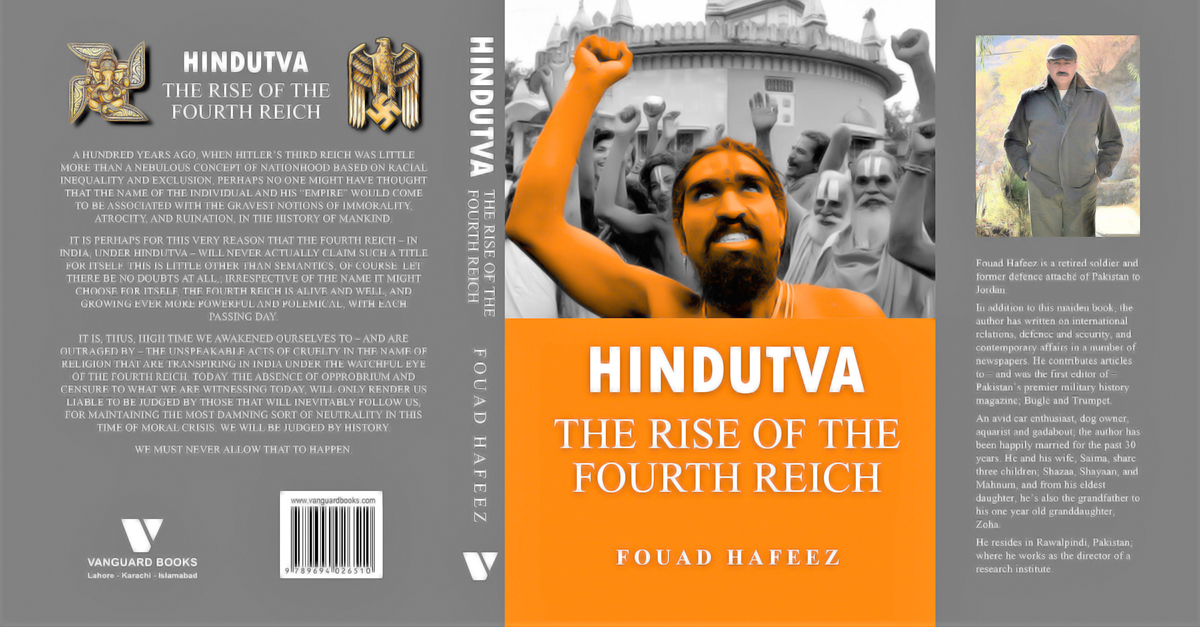SAFIA MALIK, RESEARCH OFFICER IN CISSS
Hindutva is extremist ideology of radical Hindu nationalists in India. The impact of Hindutva was never so pronounced and offensive for minorities as has been under the Modi-led BJP government. Mr. Fouad Hafeez’s book Hindutva: The Rise of the Fourth Reich provides irrefutable evidence and reads like a damning report on the manifestation of Hindutva in its ugliest form since the assumption of office by Narendra Modi in 2014. The author stresses that Hindutva has turned India into Hindustan. The book brings out similarities between Hindutva and Nazism and its impact on the domestic politics in India. The book is divided into eleven parts. At the outset, the author, inspired by Charles Dicken’s novel A Tale of Two Cities emphasizes that India and Hindustan have become two different countries just like Paris and London are two different cities with different standards of living. He has underlined that India with 1.3 billion population and area of 3.2 million sq km, is a melting pot of civilizations and cultures and a mixture of various ethnic groups including Muslims, Hindus, Sikhs and Christians. Whereas Hindustan is meant for radical Hindu nationalists who thrive on communal violence and ethnic cleansing which is alarming for non-Hindu citizens of India. The author has quoted 2002 Gujrat carnage and 2014 communal tensions in Uttar Pradesh during elections as evidence of brutalization of minorities in India. A number of separatist movements are underway in India including in Manipur, Mizoram, Tripura, Meghalaya and Assam. India has also been brutally suppressing the struggle for right to self-determination in Indian Illegally Occupied Jammu and Kashmir (IIOJK) for the last seventy-five years. The author has argued that this makes India and Hindustan two separate countries and both are in conflict with each other.
The author is of the view that Hindutva shares doctrines, belief systems and radical mindset with Nazism (p. 14). Vinayak Damodar Savarkar’s book titled The Essentials of Hindutva describes Hindustan as a nationalist or racial entity. Hitler believed in the concept of Lebensraum, which means to capture the territories of neighbouring countries through use of force and consolidating the hold through ethnic cleansing and forced migration of the natives. Savarkar advocates the application of Lebensraum as part of the concept of Akhand Baharat which envisions a Pan-Indian empire with the inclusion of today’s Pakistan, Bangladesh, Afghanistan, Sri Lanka, Nepal, Bhutan and Myanmar. Although the subcontinent was ruled by various empires that had nothing to do with “Indianness” or “Hinduness”, the concept of Akhand Baharat was implemented by India during the annexation of the state of Junagadh in 1947, Kashmir in 1947, Hyderabad in 1948 and Goa in 1961. Savarkar was influenced by Hitler’s ideology as he draws analogies between Germany’s Aryan majority and Jew minority and between India’s Hindu majority and Muslim minority. He stated in 1938, “If we Hindus in India grow stronger in time, these Muslim friends will have to play the part of German Jews” (p. 18). Mr. Hafeez also compares Nazi German Schutzstaffel (SS) with Hindu nationalist group Rashtriya Swayamsevak Sangh (RSS). SS was a small paramilitary security force that used to provide security during political party meetings. Organizational changes, ideological refueling and the emergence of radical leaders turned this small organization into a deadly one (p. 29). At the same time, RSS was taking birth in the subcontinent to target Indian minorities, especially Muslims and Christians. The author has referred to Shakha and Sangh, two branches of RSS that are infamous for instigating hatred, violence and disseminating radical Hindutva ideology among the masses (p. 32). The establishment of the Bhartiya Janta Party (BJP), a political face of RSS, gave Hindu nationalists a license to abuse Indian minorities with impunity. The author also compares the task assigned to the Third Reich of the SS for rounding up Jews from all the territories occupied by Nazi Germany and transporting them to concentration camps in Poland for extermination with the RSS-led Hindutva ideology and describes it as Fourth Reich. He recalls the address of Pakistan’s first Foreign Minister Dr. Zafarullah Khan to UN Security Council in January 1948 during which he exposed the systematic extermination of Muslims during partition. He also referred to violence by Hindus and Sikhs in Ahmadabad, Bombay, Calcutta and Bihar against Muslims during partition (p. 34). In this context, the author has referred to August 1947 edition of Daily Telegraph London, which states that only in Jullundur, 100,000 Muslims out of 200,000 residents were brutally killed and 20,000 were forced to evacuate (p. 38). The author traces the record of systematic violence by radical Hindus not only against Muslims but also against Christians. He is of the view that if extremism against Muslims by Hindutva-driven RSS Hindu zealots is compared with the murderer of Mahatma Gandhi, Nathuram Godse, the latter would appear to be a Desh Bhakt (Patriot). The author has further underlined a number of cases of violence against Muslims including Indian state-sponsored terrorism: (i) 1948 Hindu Mahasabha and RSS-backed violence in Hyderabad that left 27000 people dead; (ii) 1969 communal riots in Gujrat that left 430 Muslims killed; (iii) 1980 Muradabad killings that left 284 people dead; and (iv) 1983 Nellie Massacre, which was carried out against Muslim immigrants and left 2,191 dead. According to the author, instances of systematic use of violence against Christians include the killing of missionaries and priests, sexual assault, burning of bible and forcible religious conversion. He has stressed that violent activities of Bajrang Dal and Sangh Pariwar targeting the Christians had Indian government’s patronage.


